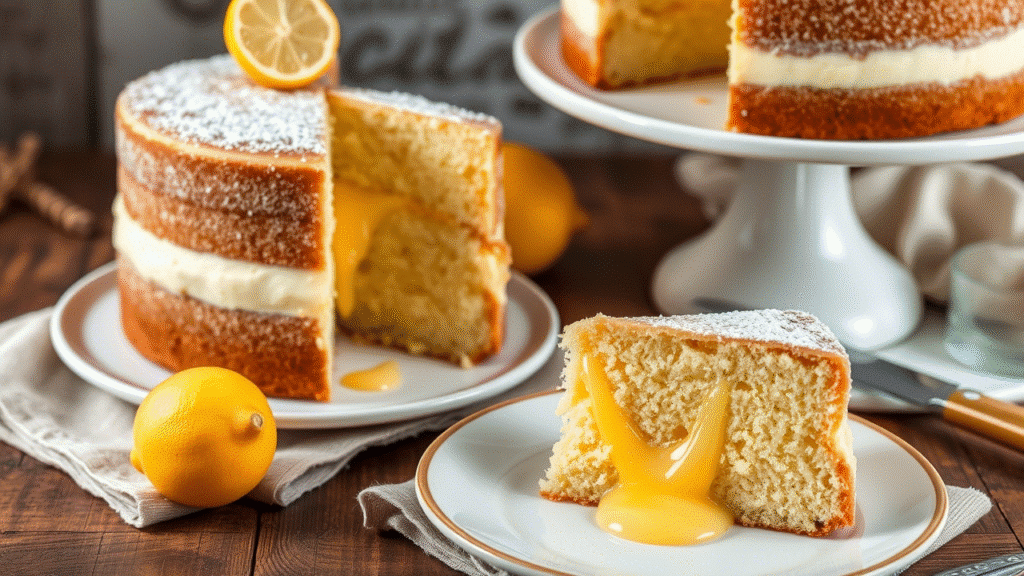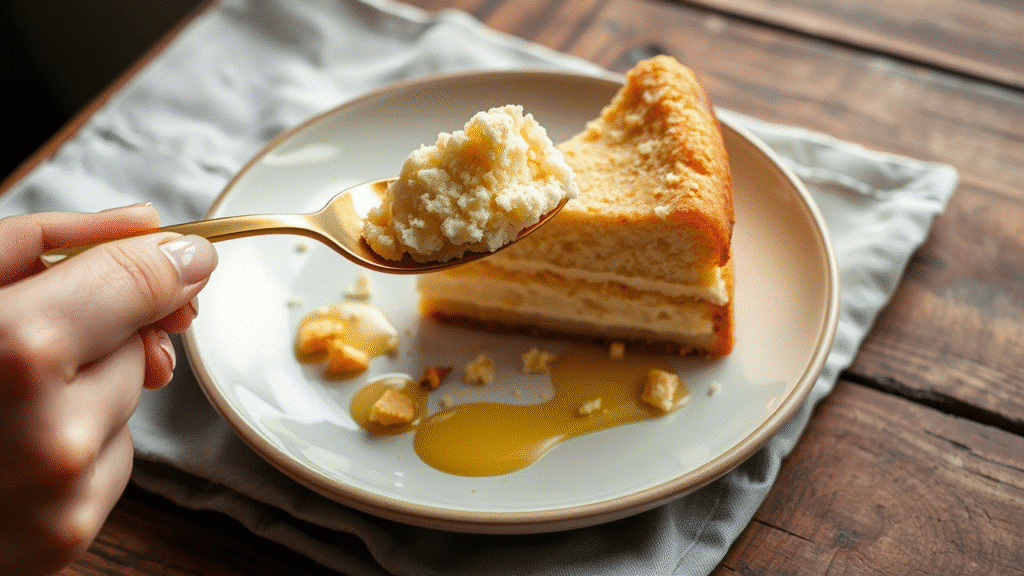I remember the first time I made this cake. I nearly threw the whole thing out halfway through. Looked like a disaster in the pan—too jiggly, too soft, and way too lemony (if that’s even a thing). But then I tasted it. Soft like pudding on the bottom, spongey on top, tangy-sweet all through. I knew I had something special. This cake doesn’t care about your doubts it just needs your oven and a little trust.
What is Lemon Custard Cake and Why It’s Worth Making
This is no ordinary lemon cake. It’s got layers literally. One batter, one pan, and boom: a light, airy sponge top, and a silky, lemony custard beneath. Magic? Not quite. It’s science (and a bit of patience).
Lemon custard cake, sometimes called magic lemon cake or lemon pudding cake, is a classic European-style dessert that plays with texture. It’s perfect for when you want something elegant but not fussy. It’s comforting but also smart kind of like that one friend who reads a lot but still laughs too loud at dumb jokes.
This recipe doesn’t require anything fancy—no mixers, no special pans, no water baths (thank god). It’s all about balance. Too much flour and you lose the custard. Too little, and you’re eating lemon soup. The charm is in the contrast.
Ingredients & Substitutions

For the Cake Batter:
- ½ cup (113g) unsalted butter, melted & slightly cooled
- ¾ cup (150g) granulated sugar
- 3 large eggs, separated
- ¼ cup (30g) all-purpose flour
- 1 ½ tablespoons lemon zest (from about 2 lemons)
- ⅓ cup fresh lemon juice (don’t even think about bottled stuff)
- 1 ¼ cups (300ml) whole milk, warmed slightly
- Pinch of salt
- Powdered sugar (for dusting)
Substitution Tips:
- Milk: You can use dairy-free milk like almond or oat, but make sure it’s unsweetened. Whole milk gives that rich custard feel.
- Flour: Gluten-free 1:1 baking flour works okay here. It’s a delicate cake, so don’t go rogue with weird flours like coconut or chickpea unless you want a sad, dry mess.
- Sugar: Coconut sugar will darken the cake and change the flavor, but it’s doable. Stevia or erythritol? Eh. I don’t recommend it unless you really know how to work with those.
- Butter: Plant-based butter or margarine is okay, but try to get one without strong flavors.
Why these ingredients matter:
Eggs are the backbone. The yolks enrich the batter; the whites give it lift. That’s how you get the dual texture custard below, sponge on top.
Fresh lemon juice is essential. The bottle stuff? It’s bitter and flat. Real juice adds acid that reacts with the whipped whites and makes that magic rise happen. Zest, meanwhile, brings oils and fragrance. Don’t skip it unless you hate joy.
Step-by-Step Instructions
Step 1: Preheat & Prep
Heat the oven to 325°F (160°C). Butter an 8×8-inch baking dish and line it with parchment, letting it hang over the edges for easy lifting later. Grease the parchment too—trust me, custard sticks.
Step 2: Whip the Egg Whites
In a clean, grease-free bowl, beat the egg whites with a pinch of salt until stiff peaks form. Don’t overbeat. You want them glossy, not grainy. Set them aside.
Tip: If your whites don’t whip, there’s probably fat or yolk in there. Start over. It happens.
Step 3: Make the Base Batter
In a separate bowl, whisk together the egg yolks and sugar until pale and slightly thick. Add melted butter and mix well. Stir in the lemon zest and juice.
Next, gently whisk in the flour. It’ll look lumpy at first—don’t panic. Slowly add the warm milk while whisking. It’ll be a thin batter. That’s normal.
Step 4: Fold in Egg Whites
Add one-third of the beaten egg whites and whisk it in—don’t be gentle here, just loosen the batter. Then fold in the rest carefully with a spatula. You’ll see clumps of whites floating in the thin batter. That’s exactly what you want.
Step 5: Bake
Pour the batter into the prepared pan. Bake for 40–50 minutes, or until the top is golden and slightly firm. The middle will jiggle, and that’s good. If you bake it too long, you’ll lose that creamy layer.
Step 6: Cool & Chill
Let it cool completely, then chill for at least 2 hours. It sets as it cools, so don’t skip this step unless you’re going for lemon soup vibes.
Tip: Dust with powdered sugar just before serving. It gets weird and clumpy if you do it while it’s still warm.
Cooking Techniques & Science
Here’s where things get interesting.
Why does one batter split into layers? It’s all about density. The thin batter lets the egg whites float to the top, where they bake into a sponge. The heavier, custardy part sinks. It’s like a reverse meringue situation, but baked.
Why warm milk? Cold milk can seize up the batter or cause curdling with the lemon juice. Warm milk helps everything blend smoothly and encourages the proteins to start binding early.
Why separate eggs? Whole eggs won’t create the same lift. Whipped whites = air. Air = sponge top. It’s basic kitchen alchemy.
Tools that help:
- Balloon whisk: For incorporating air gently.
- Fine zester: Get those lemon oils without the bitter pith.
- Offset spatula: For smoothing the top before baking. Small thing, big difference.
Serving & Pairing Suggestions

This cake is best served chilled or at room temp. A little whipped cream never hurt anyone, either. Or crème fraîche if you wanna feel fancy.
Garnish with thin lemon slices, mint leaves, or even candied zest if you’re extra. For plating, cut squares and dust with powdered sugar. Serve on dark plates for contrast.
Pair it with:
- A cold glass of limoncello (oh yes)
- Hot tea (Earl Grey or chamomile work great)
- Fresh berries or a berry compote
- Lavender or vanilla ice cream (don’t @ me)
Conclusion
Lemon custard cake is that rare dessert that impresses with minimal effort. It looks delicate, tastes bright and creamy, and carries the kind of soft sweetness that lingers just long enough. It’s got personality. It’s got chemistry. It’s got the kind of magic that only shows up when you trust a messy-looking batter to bake into something beautiful.
Want it more tart? Add more zest. Want it richer? Swap milk for half cream. Want it lighter? Use less sugar. It’s a cake that bends, not breaks.

